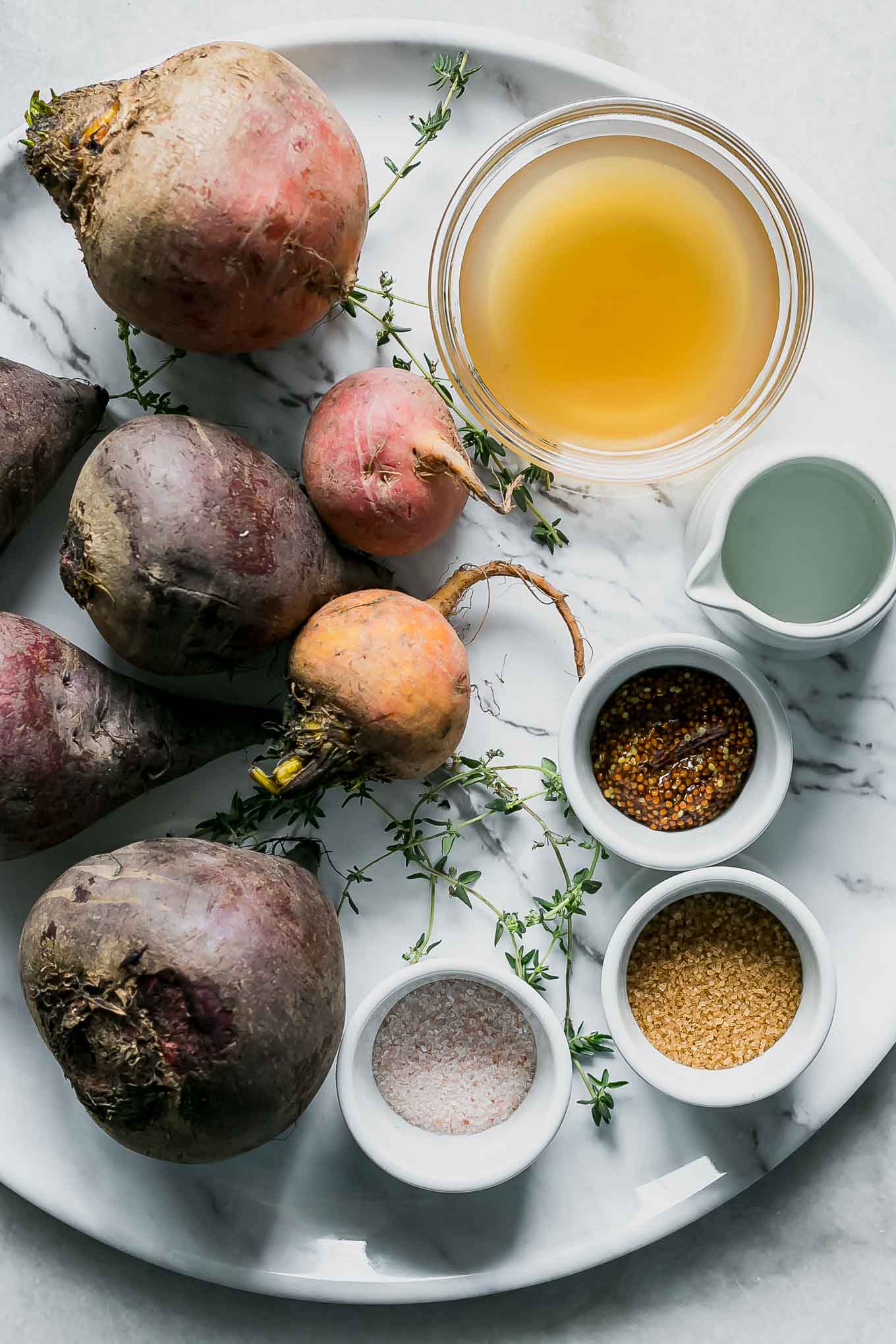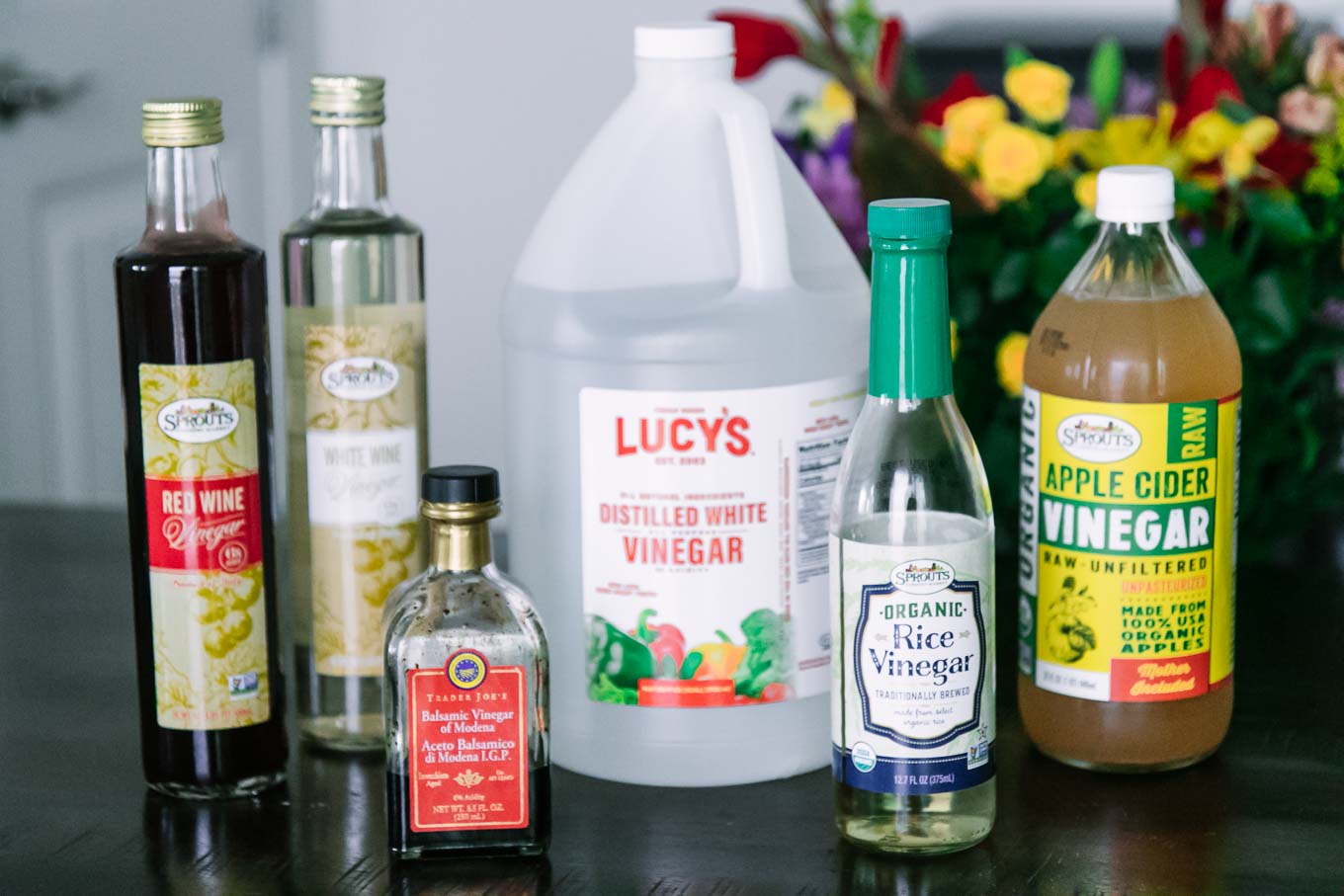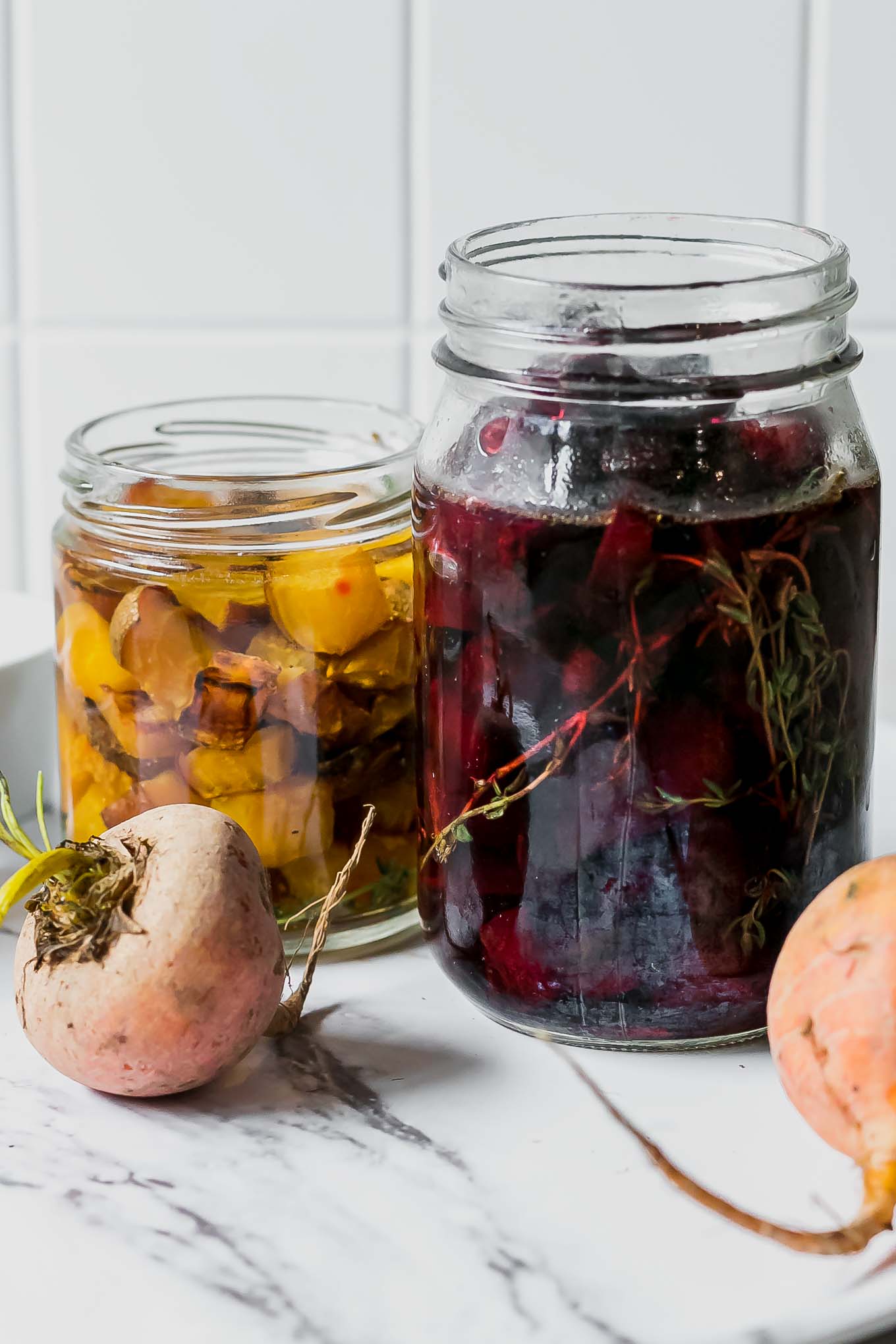Quick Refrigerator Pickled Beets
Quick Refrigerator Pickled Beets, an easy pickled beets recipe made with apple cider vinegar and cinnamon. Ready to eat in as little as 2 hours!

Want to Save This Recipe?
Enter your email & I’ll send it to your inbox. Plus, get new plant-based recipes in your inbox!
By submitting this form, you consent to receive emails from Fork in the Road.
Love pickled beets? Quickly pickle cooked (or raw) beets in the refrigerator in just 2 hours! Making refrigerator pickled beets is a great way to preserve beets while in-season so you can take advantage of their flavors all year long.
Ready to learn how to quick pickle beets in the refrigerator? Let’s do it!

🥣 How to make (step-by-step)
1️⃣ Step One: Cook the beets
The first step to quick pickling beets is to cook them. We suggest pickling roasted beets for the best flavor, but you can also steam them as well.
👉 Here are two ways to cook the beets before pickling:
- To roast the beets in the oven, first cut them into 1/2 inch cubes and drizzle with olive oil before cooking for 20-25 minutes at 400 degrees F (no need to peel the beet).
- To steam the beets, bring a pot of salted water to a boil and drop in trimmed and peeled whole beets (about 2-3). Boil for 30 minutes or until a knife easily spears the beet, then remove to let cool and slice into 1/2 inch thick cubes.

👉 Wondering how to store beets? Check out our guide on How to Store Beets.
2️⃣ Step Two: Prepare the pickling jar
Put the cooked and cooled cut beets into a jar with a wide mouth along with mustard (stone ground or mustard seeds work well), a cinnamon stick, and a couple of garlic cloves.
If you have other veggies, like sliced red onions or radishes, you can add them to the jar if you’d like.

3️⃣ Step Three: Prepare and add the brine
You can’t make pickled vegetables without brine! This salted and sugared vinegar water is what adds the “pickled” flavor to beets.
Our go-to refrigerator pickling brine formula is:
- 1 cup water
- 1 cup vinegar (apple cider vinegar is our favorite for beets)
- 1 tablespoon salt
- 1 tablespoon sugar*
*However, we like to add a bit more sugar to a pickling brine for beets to really enhance their natural flavors. So we’re increasing the amount of sugar for this brine to 1/4 cup (we like brown sugar, but granulated white sugar works as well).
To make the brine, simply add water, a vinegar, salt, and sugar to a medium saucepan and bring to a boil.
Pour the hot brine into the pickling jar and completely cover the beets, then allow it to cool down on the counter until it reaches room temperature (about 20-30 minutes).
💡 Want more tips for making pickling brine? Check out my full recipe, tips, and advice for making a refrigerator pickling brine here.

Which vinegar should you use for pickling beets? We like apple cider vinegar or red wine vinegar for pickling beets. For the mildest flavor choose distilled white vinegar. For an extra flavor kick, try white wine vinegar. Malt and balsamic vinegar have the strongest flavor.

4️⃣ Step Four: Quick pickle the beets in the refrigerator
Once the jar is cool, put the jar into the refrigerator and allow the beets to absorb the pickling brine to become “quick pickled.”

⏰ How long to quick pickle beets
If you want to serve quickly, let the beets pickle for at least 2 hours. For best results, we recommend letting the beets soak up the brine for at least 24-48 hours.
Refrigerator pickled beets are good up to one month in the refrigerator as long as they are submerged in the brine.
❓Questions and quick tips
You can quick pickle raw beets in the refrigerator, but they will retain their raw crunchy texture and will not absorb as much of the pickling brine. If you do decide to pickle the beets raw, we suggest cutting them into very small cubes or even slices to allow them to become softer, and also to let them pickle for longer before eating (maybe minimum of 2-3 days, but a week is ideal so they become soft).
Choose a jar that’s tall enough to store the store stacked beets, but wide enough to easily remove them for serving. There should be about 1/2 – 1 inch (1-2 cm) of space between the beets and the lid so that they can completely submerge in the brine liquid.
You can eat pickled beets after they have been in the refrigerator for at least 2 hours. However, we suggest waiting for 24-48 hours for the best results.
As long as the beets are completely covered with brine, they will last for up to one month in the refrigerator. If any part of the beets are sticking out of the water, there is potential for bacterial growth, so make sure to use a tall jar and to completely submerge them in the brine.
You can pickle any type of beet: red, golden, chiogga, avalanche – the possibilities are endless for pickling!
Quick pickling vegetables does not come with the same food safety hazards as traditional pickling and canning. However, to make sure your beets stay safe while stored in the refrigerator, make sure to completely cover them in the liquid brine and to feel the beets before eating. If they’re slimy, throw them out.
♻️ Sustainable kitchen tips
Take advantage of beet season! The best time to make pickled beets is at the peak of beet season! In Northern California that’s almost year around (minus the early summer months), but check out Seasonal Food Guide’s produce seasonality calendar to find when beets are in season where you live.
Keep jars to use for quick pickling. We’re always looking for jars to keep on hand for pantry and food storage. Look out for larger jars that you can remove the label from and save to use for picking vegetables later (try our simple method for removing labels using natural ingredients).
Reuse beet greens! Don’t throw out beet greens, use them in pesto sauce, add them to a soup, or sauté them for a tasty side dish.

💚 More quick pickling recipes
Looking for more quick pickled vegetable recipes? We’ve got you covered:
- Quick Pickled Carrot Ribbons
- Quick Dill Pickled Radishes
- Easy Quick Pickled Asparagus
- Refrigerator Pickled Shallots

NOT SURE WHERE TO START WITH PLANT-BASED EATING?
Get my 4-Day Plant-Based Meal Plan to start your journey on the plant path.

Quick Refrigerator Pickled Beets
Ingredients
- 1 pound cooked beets see instructions
- 2 tablespoons mustard stone ground or mustard seeds
- 1 whole cinnamon stick
- 2 cloves garlic sliced thin
- 2 cups water
- 1 cup apple cider vinegar see notes
- 2 tablespoons salt
- ¼ cup sugar granulated white or brown
- Optional: thinly sliced red onions or radishes, fresh herbs
Instructions
- Cook the beets: The first step is to cook the beets before pickling, we suggest roasting for best flavor but steamed beets work as well. To roast the beets in the oven, first cut them into 1/2 inch cubes and drizzling with olive oil before cooking for 20-25 minutes at 400 degrees F (no need to peel the beet). To steam the beets, bring a pot of salted water to a boil and drop in trimmed and peeled whole beets (about 2-3). Boil for 30 minutes or until a knife easily spears the beet, then remove to let cool and slice into 1/2 inch thick cubes.
- Prep the pickling jar: Add the cooked beet cubes to a large jar with a wide mouth with the mustard, cinnamon stick, and garlic cloves.
- Prepare and add the brine: In a medium saucepan bring the water, apple cider vinegar, salt, and sugar to a boil. Once boiling, pour the brine into the jar until the liquid completely submerges the beets. Let the jar cool uncovered for 20-30 minutes.
- Pickling instructions: Once cooled, put the jar into the refrigerator and let the beets pickle for at least 2 hours before serving, but for best results serve after at least 24 hours. Quick pickled beets are good up to one month in the refrigerator.
Notes
- Vinegar recommendations: We like apple cider vinegar for pickled beets, but white vinegar, white wine vinegar, and red wine vinegar are also delicious.
- Recommended jar: Choose a large and wide jar so the beets fit within the jar with about 1/2 – 1 inch space (2-3 cm) below the lid.
- Other recommended tools: small saucepan, cutting board, knife set
- Prep ahead and storage: Refrigerator pickled beets should be made at least 2 hours before serving, but for best results make at least 24-48 hours ahead. Keep the jar refrigerated and it can be enjoyed for up to one month. Do not freeze.

